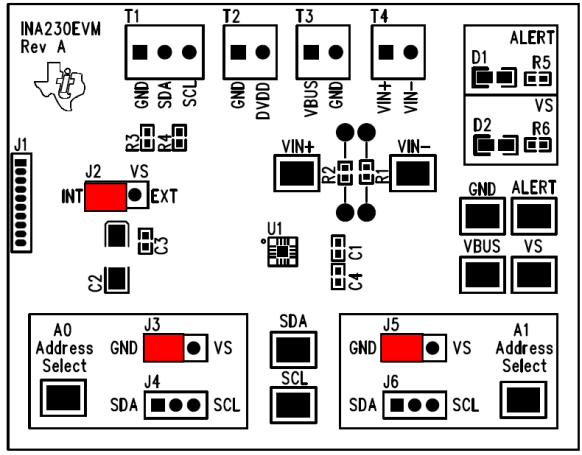SBOU124B march 2012 – july 2023 INA230
- 1
- INA230EVM Evaluation Board and Software Tutorial
- Trademarks
- 1Overview
- 2INA230EVM Hardware
- 3INA230EVM (Rev A) Hardware Setup
- 4INA230EVM Software Setup
- 5INA230EVM Software Overview
- 6INA230EVM Documentation
- 7Revision History
3.5 INA230EVM Default Jumper Settings
Figure 3-4 shows the default jumper configuration for the INA230EVM. In general, the jumper settings of the SM-USB-DIG Platform do not need to be changed. Users may want to change some of the jumpers on the INA230EVM board to match their specific configuration. For example, users can set a specific I2C address by configuring J3-J6.
 Figure 3-4 INA230EVM Default Jumper Settings
Figure 3-4 INA230EVM Default Jumper SettingsTypically, jumper 2 on the INA230EVM is always set to the INT position. When set to the INT position, the SM-USB-DIG Platform provides the supply for the INA230. When this jumper is set to the EXT position, an external supply voltage can be connected to terminal strip T2 to provide the supply for the INA230.
Jumpers 3 through 6 control the I2C address pins for the INA230. These jumpers can set the address for A0 and A1 to either supply, ground, SCL, or SDA. Make sure to only connect one jumper at a time for each address control. Failure to properly connect jumpers can cause shorts or interruptions in the communication lines. See also the INA230 data sheet.
Table 3-1 summarizes the function of the INA230 Test Board jumpers. For most applications, all jumpers should be left in the respective default configurations.
JUMPER | DEFAULT | PURPOSE |
|---|---|---|
| J2 | INT | This jumper selects whether the VS pin on the INA230 is connected to the VDUT signal generated from the SM-USB-DIG Platform or whether the digital supply pin is connected to terminal T2, allowing for an external supply to power the device. The default INT position connects the VS pin to the VDUT control signal. |
| J3/J4 | GND | This jumper selects the I2C A0 address selection for A0. |
| J5/J6 | GND | This jumper selects the I2C A1 address selection for A1. |